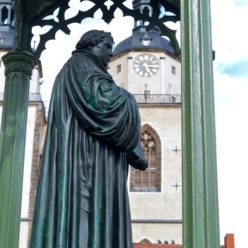M. Baumann1, M. Gopalswamy1, J. Adler2, B. Voigt1, D. Huster2,
and J. Balbach1
1Institute of Physics, Biophysics, University Halle-Wittenberg, Germany
2Institute for Medical Physics and Biophysics, University Leipzig, Germany
Amyloids are well ordered protein aggregates involved in many functional and pathogenic processes of life. Various structural models of the molecular architecture of amyloids have been derived in the last decade mainly driven by advances in solid state NMR. This talk will summarize our NMR efforts to study not only structural features of mature fibrils but the amyloid formation mechanism. Two systems will be covered: the Alzheimer peptide Aβ(1-40) and variants as well as the human parathyroid hormone PTH(1-84). For Aβ(1-40) we show that backbone hydrogen bonds are the main driving force for fibril structure formation overwriting side chain effect and buffer conditions [1,2]. Additionally, we show that morphological properties of fibril seeds do not necessarily propagate towards the growing fibril [3]. Several molecular observations during the formation of PTH(1-84) fibrils will be presented [4] to classify them as functional amyloids and possible storage form of the hormone.Amyloids are well ordered protein aggregates involved in many functional and pathogenic processes of life. Various structural models of the molecular architecture of amyloids have been derived in the last decade mainly driven by advances in solid state NMR. This talk will summarize our NMR efforts to study not only structural features of mature fibrils but the amyloid formation mechanism. Two systems will be covered: the Alzheimer peptide Aβ(1-40) and variants as well as the human parathyroid hormone PTH(1-84). For Aβ(1-40) we show that backbone hydrogen bonds are the main driving force for fibril structure formation overwriting side chain effect and buffer conditions [1,2]. Additionally, we show that morphological properties of fibril seeds do not necessarily propagate towards the growing fibril [3]. Several molecular observations during the formation of PTH(1-84) fibrils will be presented [4] to classify them as functional amyloids and possible storage form of the hormone.
References
[1] M. Garvey, M. Baumann, M. Wulff, M. Fändrich, J. Balbach et al., Amyloid 23, 76 (2016). (link)
[2] J. Adler, M. Baumann, B. Voigt, H. A. Scheidt, D. Bhowmik, T. Haupl, B. Abel, P. K. Madhu, J. Balbach, S. Maiti, and D. Huster, ChemPhysChem 17, 2744 (2016). (link)
[3] M. Wulff, M. Baumann, J. Balbach, M. Fändrich et al., Angew. Chemie Int. Ed. 55, 5081 (2016). (link)
[4] M. Gopalswamy, A. Kumar, J. Adler, M. Baumann, M. Henze, S. T. Kumar, M. Fändrich, H. A. Scheidt, D. Huster, and J. Balbach, Biochim. Biophys. Acta 1854, 249 (2015). (link)
